 |
The Church of St Matthew, Little Bolton |
 |
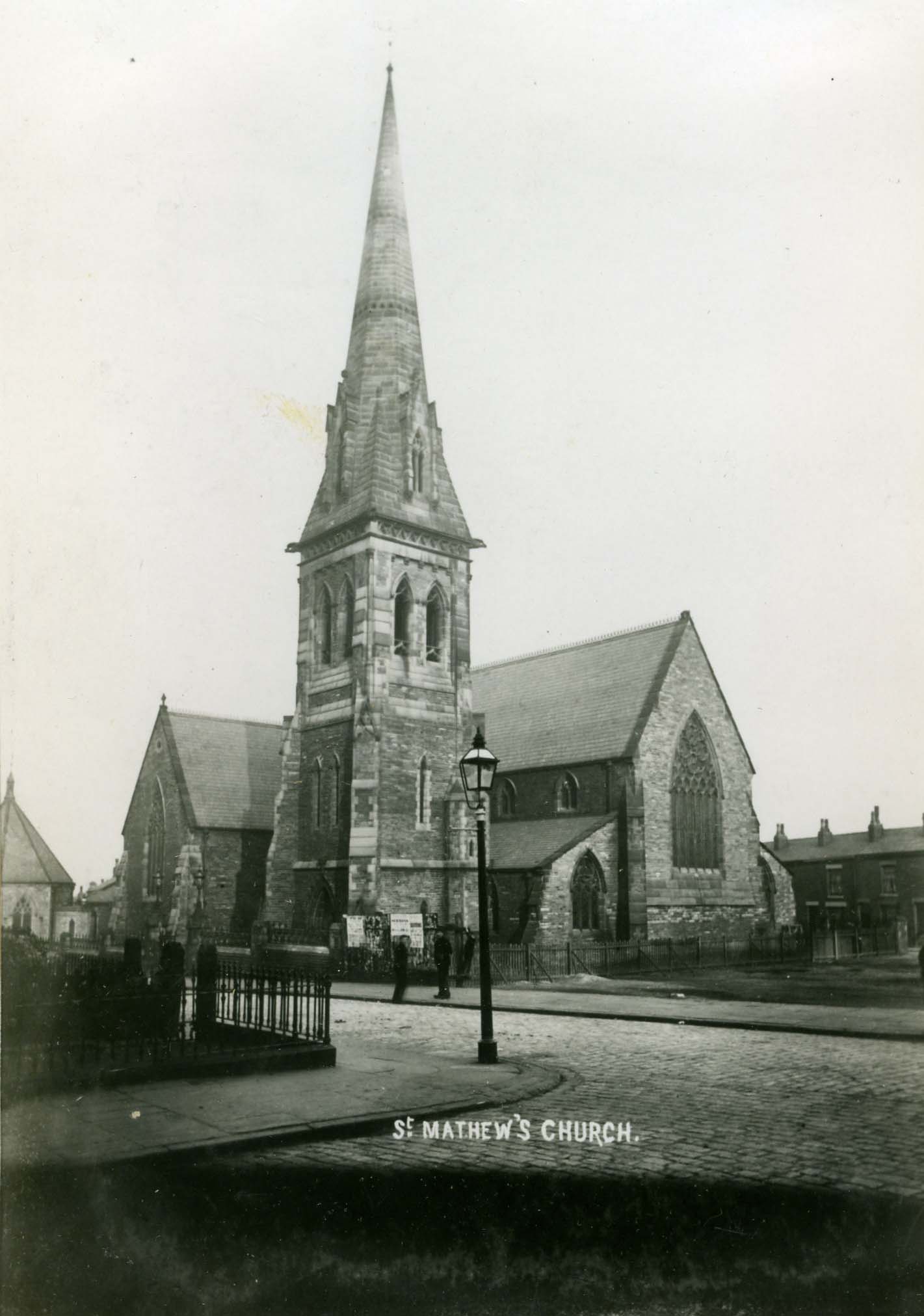 | |
Photograph courtesy of Halliwell Local History Society |
St Matthew, Mount St. Little Bolton was consecrated on 13 Sept. 1876. The Spire of St Matthew's was a notable landmark, rising 87 feet above its tower. In 1947 the Spire was leaning at an alarming angle so the top 30 feet was removed. The stones were numbered and arranged in the Churchyard, with plans to rebuild. Unfortunately the foundations were found to be inadequate and in 1955 the rest of the Spire was removed, leaving just the Tower.
The Parish of St Matthew united with the Parish of St Barnabas by Order in Council 27 October 1971 to become the Parish of St Matthew with St Barnabas. The church of St Barnabas was declared redundant in 1974.
Following the closure of St Barnabas in 1973, St Matthew was the only CofE in the newly created Parish of St Matthew with St Barnabas.
The Church of St Matthew closed in 1982 and was subsequently demolished due to dry rot.
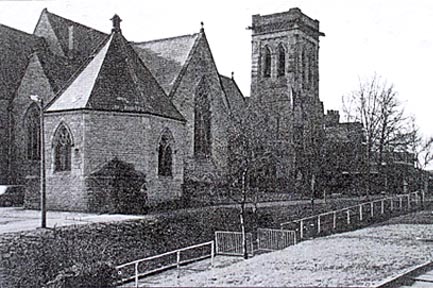 | |
Photograph courtesy of Halliwell Local History Society |
The Worship Centre on Brownlow Way was built in 1981 to replace the original Church of St Matthew, which had been deemed beyond economic repair due to dry rot. The centre was licenced for marriages from 1st December 1981. A note from the Marriage Register for the period states:-
"St Matthew's Church became redundant on April 1st 1982.
All services are now held in St Matthew's Worship Centre, Brownlow Way, Bolton"
St Matthew was closed during 2013.
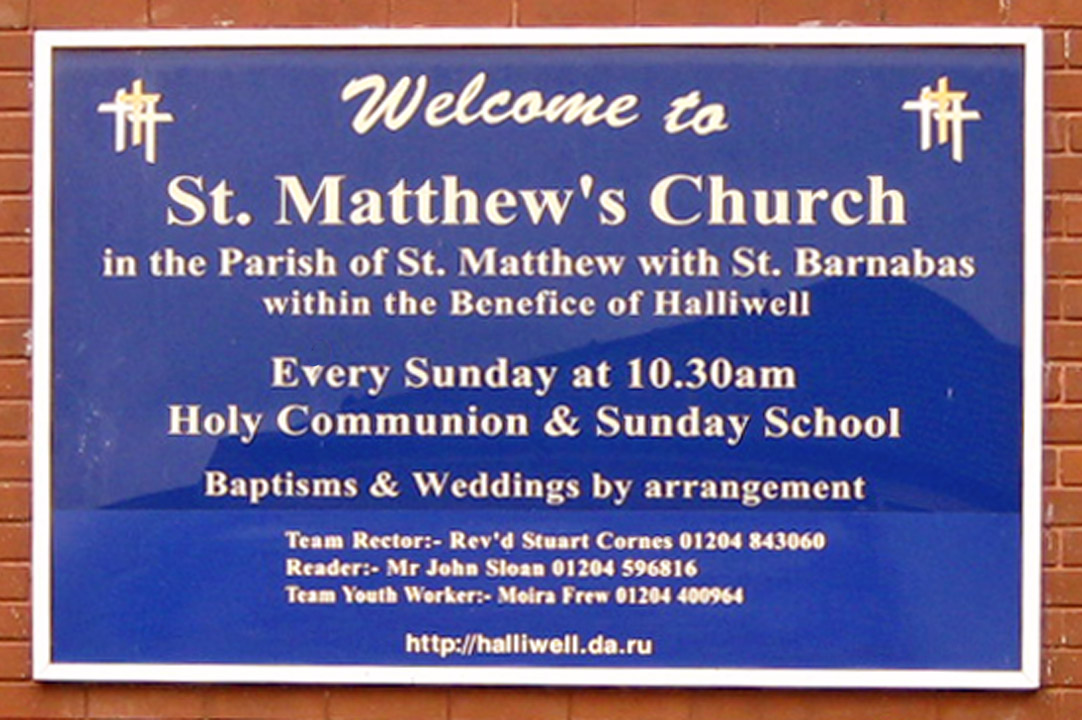 | |
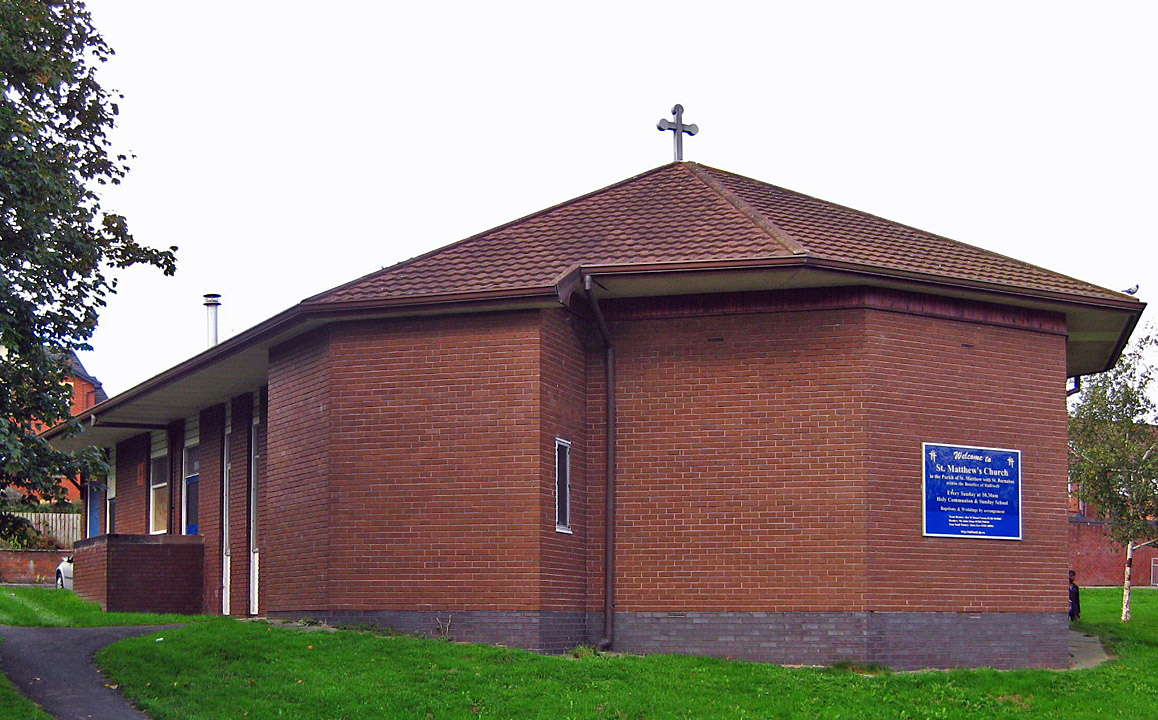 | |
From the Bolton Journal and Guardian, Friday, September 4, 1936, reproduced here by the kind permission of the Bolton News.
A Cause that Grew with Brownlow Fold
St. Matthew's Church
One cannot easily associate in one's mind Brownlow Fold with green fields and country scenes. Yet less than threequarters of a century ago the site of St. Matthew's Church in Mount St. presented a pastoral appearance, with cattle grazing contentedly. For about this same spot was situated a farm known as "Owd Charnock's," which formed part of Mere Hall estate.
St. Matthew's---the diamond jubilee of its consecration falls on September 13th---is a daughter church of St. George's, which in the 'seventies, had as many as 20,000 parishioners.
About 1870 the buildings now used as the infants' school and the parochial hall, together with the adjoining classrooms on the ground and upper floors, were erected to meet the needs of the people living some distance away from St. George's Church.
This early mission was superintended by the Rev. Wm. Ridley, curate of St. George's, and he was assisted by several stalwarts of St. George's, who afterwards became firm and generous supporters of the daughter church---Mr. Thomas Holmes, Mr. Nathan Porter, Mr. (afterwards alderman) and Mrs. John Green, Mr. John Harrison and Mr. Thomas Loftos, who afterwards became Town Clerk of Blackpool.
In those early days there was a trapdoor on the upper floor which was opened so that worshippers on the upper and ground floors could join together in the hymns and prayers.
The mission made such a progress that in 1874 a new district was carved out of St. George's parish to be called St. Matthew's. The Rev. Neville Jones was then vicar of St. George's and of his 20,000 parishioners 8,000 were assigned to the new district.
Mr. C. Cronshaw, who had been a curate at St. George's and vicar of Pennington Church, Leigh, was appointed first vicar of St. Matthew's. Mr. Cronshaw worked zealously but unostentatiously in his new sphere and with his coming full morning and evening services were held at the Mount-st School. Under his leadership and guidance, enthusiasm increased, and eventually a new school, the present boys' school, was built, equipped as a church and became known as St. Matthew's Temporary Church. The late Ald. Nicholson gave very generously to this project and took a deep interest in the work of the parish.
St. Matthew's parishioners did not have to worship for long in this temporary church however, for within three years of Mr. Cronshaw's appointment as vicar, the present church had been erected and consecrated. Difficulty was experienced in securing a firm foundation for the new church, but eventually perseverance was rewarded, a good foundation found, and Mr. Cronshaw cut the first sod.
The new church was made possible very largely through the generosity of Ald. and Mrs. Green, of Mayfield, Mr. and Mrs. William Nicholson, Mr. Thomas Holmes and other members of St. George's congregation.
It was dedicated on September 13th. 1876, by the then Bishop of Manchester, Dr. Fraser.
The organ was the gift of Mr. and Mrs. William Nicholson, and the pulpit of Ald. and Mrs. Green, who in addition to other generous contributions, gave the spire and a considerable part of the endowment. At a bazaar held in the Albert Hall, £2,300 towards the new church was realized---evidence that the congregation was in earnest.
The spire and the vicarage were added after the consecration of the church.* A few years later the numbers had so increased that the schools had to be extended. Later some old cottages, known as St. James's terrace, were purchased through the generosity of Mr. John Leach, and converted into a Sunday school and mission church.
The present reredos at St. Matthew's was the gift of Mr. Thomas Holmes. It is made of olive wood, which he brought from the Holy Land, whilst the stone which forms part of it was obtained from a spot near to the reputed site of Our Lord's grave.
After 16 years at St. Matthew's, Mr. Cronshaw accepted in 1890 the living of Westhoughton, and when he left there were 700 regular Communicants and 2,000 Sunday school scholars at St. Matthew's. One of the men who came under Mr. Cronshaw's influence was John Charles Wright, afterwards Archbishop of Sydney, Australia.
Mr. Cronshaw was succeeded by the Rev. Wm. Pearson, during whose vicariate the octagonal vestry was built. In 1891 the stained glass window at the west end was erected to the memory of Mrs. Green, the one at the east end having been erected some years previously to the memory of her husband, Ald. Green. J.P. Thus are two devoted workers of St. Matthew's early days remembered.
Mr. Pearson left St. Matthew's in 1894 and was succeeded in the following year by the Rev. E.S.Richardson, and early in his vicariate the vicarage was built.
Mr. Richardson left in 1909, his successor, the Rev. Samuel Taylor, during whose vicariate the position of St. Matthew's was considerably strengthened, being inducted in the following year. He died in 1923, and was succeeded by Rev. Spencer Wade, who however remained only for a brief period. He was succeeded by the Rev. F.G.Hurst*
* Due to the damage to the newspaper, it was not possible to completely transcribe the whole article.
And from an earlier article in the Bolton Journal and Guardian, from 1885, reproduced here by the kind permission of the Bolton News.
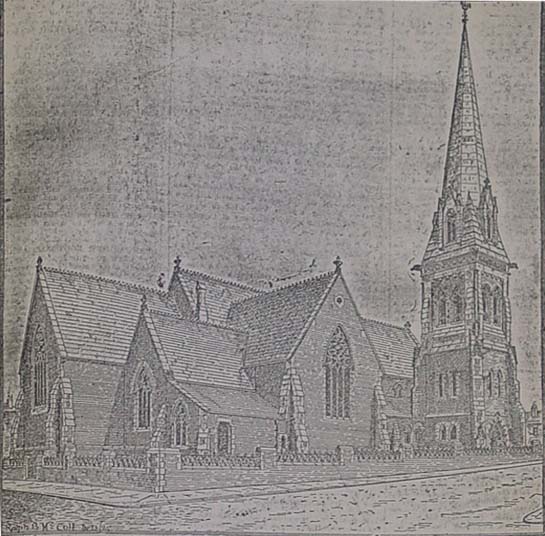 | |
From a drawing courtesy of the Bolton News |
St. Matthew's Church, Mount St. Little Bolton
St. Matthew's Church, Little Bolton, is one of the chief branches from the parent stem of St. George's, and the entire movement for founding the parish and erecting the church may be attributed to the energy and liberality of one man, the late Alderman John Green. This ardent churchman took the liveliest interest in the work, first securing land for a site for the school and vicarage at a cost of £1,000, and then offering £3,000 to commence a fund for the erection of the church, namely £1,000 in the name of his wife, £1,000 in memory of his sister, Miss Ann Green, and £1,000 in his own name. These gifts he afterwards supplemented by contributing £1,150 towards the permanent endowment of the church, and still later he undertook the sole charge of erecting the tower and spire at a cost of £2,400. The movement for the separation of St. Matthew's parish from St. George's, and the erection of the church commenced from the time of the building of the lower school In 1869 at a cost of £1.000 through the instrumentality of the Rev. Neville Jones. M.A., the venerable Vicar of St. George's. Evening service was here conducted by the Curate of St. George's or laymen until December, 1873, and on January 1st. 1874, the Rev. C. Cronshaw came into residence as Incumbent Elect of the district proposed to be carved from St. George's Parish and made into a separate parish. For some time service was held in the upper schoolroom but the congregation was becoming too large for accommodation another school was erected at a cost of £1,500, and used as a temporary church, mainly through the munificence of Alderman Nicholson, J.P., who contributed £1,000 towards the cost. The new parish was formed and gazetted on the 20th. Sept., 1873, and on March 29th. 1876, the foundation stone of the new church was laid by Ald. Green. Towards the building fund a most successful bazaar was held in the Albert Hall in March, 1875, when the splendid sum of £2,300 was realized. Of the Bazaar Committee, the Rev. C. Cronshaw, the new vicar, was chairman: and Mr. Thomas Loftos, Town Clerk of Blackpool, the indefatigable secretary. The church is a very beautiful building, in every way suitable for Divine worship, and was erected at a cost of £14,000, from public subscriptions obtained by the Vicar and the Building Committee. This sum includes the cost of the organ, the joint gift of Alderman and Mrs. Nicholson, the pulpit, provided at the expense of Mrs. Green, the lectern and font by the Sunday School teachers and scholars, the covers and linen for the Communion Table by Mrs. Higson, and the Communion chairs by Mrs. Nicholson. The Consecration of the church took place on September 13th,1876, by the Lord Bishop of Manchester, who preached the sermon and afterwards administered Holy Communion to 300 communicants. In November 1879, a beautiful east window was erected by public subscription to the memory of the late Ald. Green in token of the gratitude of the congregation and their ___ to one who proved himself so great a benefactor to the church and parish. Two stained glass memorial windows have been erected in the south aisle, one by John Leach, Esq., Haverhill House, to the memory of his son, Mr. Thomas Leach, and the other by Thomas Holmes, Esq., in memory of his infant daughter. We may add that the elegant brass rail has been added to the pulpit by Mrs. Green, of Mayfield. In 1884 the church was beautified by Mr. Gregson, decorator, according to the plans prepared by the architects, Messrs.T.D.Barry and Son, Liverpool, at a cost of upwards of £600. The chancel has been paved with marble mosaic at the sole expense of Thomas Holmes, Esq., in memory of his sister, the late Miss Elizabeth Holmes, the cost being £200. In 1879 the schools were found to be too small, and were enlarged by the vicar and his committee at a cost of £800, by the erection of two class-rooms and a lecture-room. The present accommodation of the school is now 1100 scholars. The parish is a poor one, being, with the exception of the Freehold, occupied almost exclusively by artisans and their families. Both church and schools have, however, continued steadily to flourish, the day schools are in the front rank, the Sunday schools are larger than those connected with any other parish in the town, and the communicants present on Easter Day numbered the magnificent total of 602.
| Bolton Home & Contents | ©Lancashire OnLine Parish Clerks | Lancashire Home |